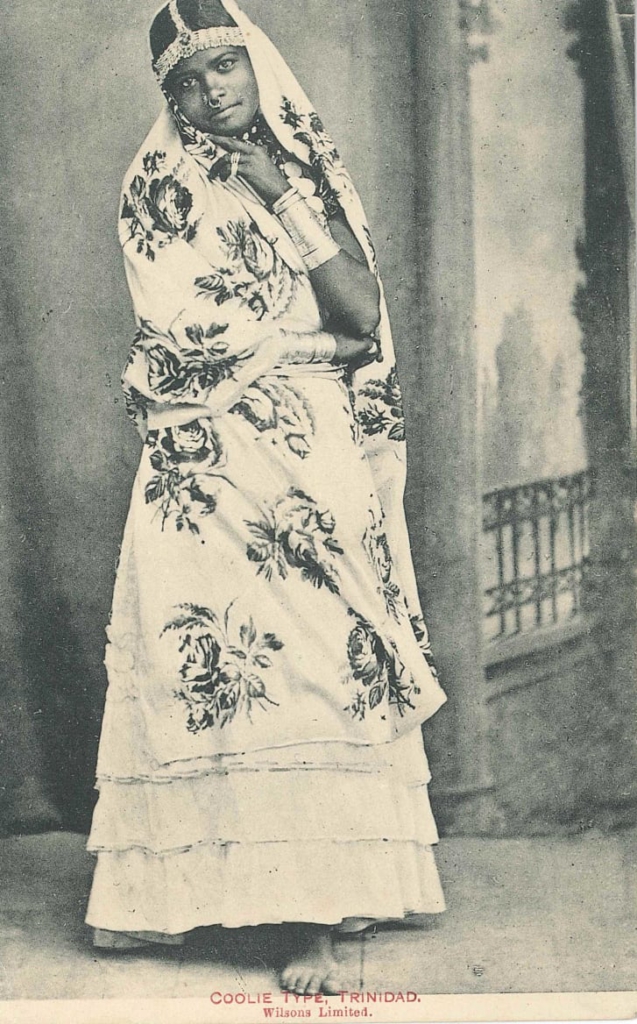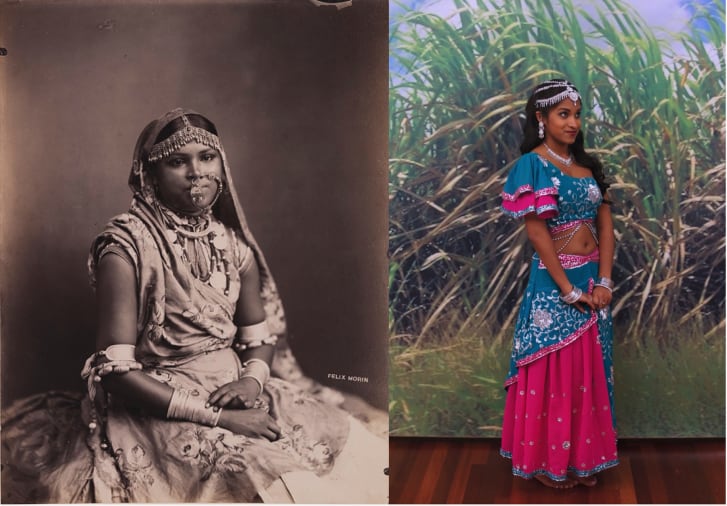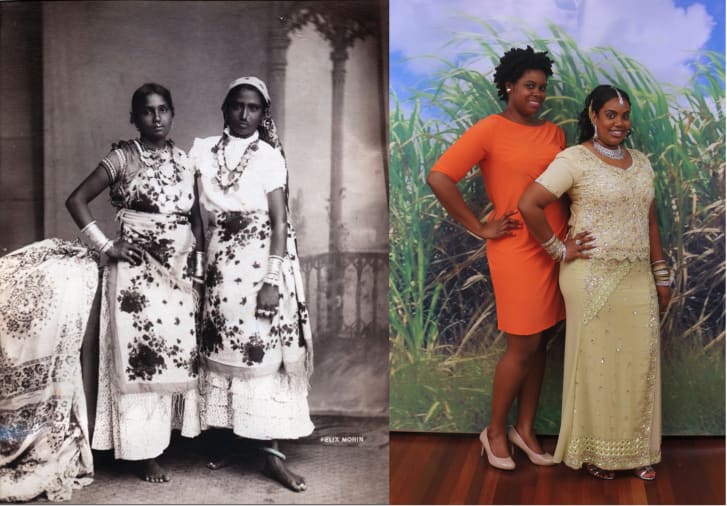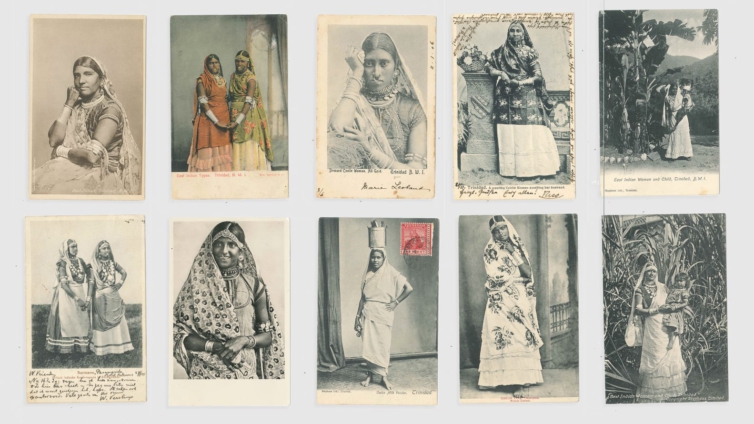On the fronts of 19th-century postcards displayed in Caribbean shops, women in traditional Indian styles portrayed the islands as lush and exotic tourist destinations.
The models posed coyly, dressed in traditional lehenga cholis garments and ornamented in elaborate gold and silver jewelry -- bell-shaped jhumkas (a classic style of earring) and all.
Simply referred to as "coolie belles" on the cards, the women wcere nameless and mysterious protagonists. They were often pictured in photography studios, leaning against European-esque pillars; sometimes they posed in front of cane fields.

Thousands of miles away from their homeland, these Indo-Caribbean women were some of the 2 million indentured laborers the British transported to their colonies between 1834 and 1917. In the Caribbean, they signed contracts for five years or longer and worked on sugarcane fields on islands like Guyana, Trinidad, Surinam and Jamaica after slavery had officially ended.
Yet they toiled away on the same plantations, lived in the same quarters and were transported on boats of similar conditions to slave ships, according to Rupa Pillai, a senior lecturer of Asian-American studies at the University of Pennsylvania.
They were also referred to as "coolies" by British authority -- a highly charged slur used to represent Asian manual workers -- and were often physically abused.
An understudied history
This past year marks a century since the final abolition of indenture contracts in the Caribbean, yet there often little attention given to the history of the exploitative practice, which had a seismic impact on the world.
"It was the largest mass migration of people in the 19th century, (but it was) completely ignored when the system ended," said Indo-Caribbean scholar David Dabydeen over the phone.
Dabydeen is the director of the Ameena Gafoor Institute, whichstudies indentureship and its legacies.
Pillai shares this frustration. "So much is tied with indenture but it's largely invisible which is so aggravating," she said in a phone interview.
As Indians faced tumultuous political upheaval and famines in the 19th century, the country was ripe for Britain to exploit, according to Pillai. Indentureship was falsely advertised as a way for Indians to see a better life.
Contracts were written in English, yet the people signing them had high levels of illiteracy. Women who had been disowned by their families and widows were particularly vulnerable. If your husband had died "your life was basically over, even if you were young," said Pillai.
Women were also actively recruited by the British to satisfy and carry out domestic work for the male-majority population of indentured workers. With approximately 30% of the entire indentured population being women, according to Pillai, men were often in competition for partners, while violence and sexual abuse against Indian women was not uncommon.
Despite such a low percentage of women present as laborers, they feature predominatelyon postcards from the time.
Exploitative photography
As photography became more accessible, and tourism to the Caribbean islands increased under British colonial rule, the local postcard industry rose to prominence.
Owning postcards came to symbolize cosmopolitanism and a well-traveled individual. Postcards attempted to "create this image of the Caribbean, as beautiful, but also safe," said Gaiutra Bahadur, author of "Coolie Woman: The Odyssey of Indenture," over video.
In a way, she added, the postcards tried to do "a PR job with colonialism."
The scenes were entirely controlled by White European photographers -- one of whom was Felix Morin, a French commercial photographer who owned a studio in Trinidad's capital, Port of Spain, from 1869 through to late 1890.

With the models dressed in their best jewelry -- symbolizing wealth -- and traditional clothing, the photographs exocitized and sexualized them, hiding the "background of labor and violence" they experienced, according to Bahadur.
The images seemed to say, as Pillai described, "We've colonized them. They're lovely docile, civilized individuals that you can come and look at -- come to the Caribbean!"
The postcards of Indo-Caribbean women were far from the only early exploitative uses of photography. As the medium was popularized, its use within anthropology was often fraught, presented as evidence for racist claims.
In 1868, British colonial administrators commissioned the eight-volume visual encyclopedia "People of India," characterizing different types of Indians by caste, religion and tribe.
Pillai sees a link between the postcards and photographic projects like "People of India."
"It's that kind of visual language you can see present in these postcards and other postcards that were happening at the time," she said. The images showed the women as "other," an idea further enforced by their arms and legs being on display.
With the postcards published at the height of the Victorian era, the exposure of hands and feet would have been shocking. "(Their) White women counterparts would have been completely covered," she said.
Personal connections
Well over a century later, visual artist Andil Gosine reimagined the postcards in his photo series "Cane Portraiture."
Gosine lived in Trinidad until he was 14 and is a descendent of Indo-Trinidadian indentured workers. For the series, Gosine invited Caribbeans who had migrated to New York to pose against a backdrop of sugarcane fields.
There was a performative aspect to the work, which was eventually printed as a set of postcards."('Cane Portraiture') was primarily about the interaction with myself and the subjects as a way of imagining what was going on between Felix Morin and the Indian indentures," Gosine said in a phone interview.

In contrast to Bahadur and Pillai, who believe the woman had little power over their images in the postcards, Gosine thinks the reality may have been a bit more complex.
"Sometimes I think the stories are too simple, like: 'Oh, here's the colonizer with all the power...controlling the form of representation.' I believe there's a negotiation (in photography)," he said.
"I don't think we should strip the subjects of all their agency. When I look at his images, I see possibilities that perhaps they were choosing how they were wanting to be represented as well."
The work helped him understand more about his longing for the Caribbean, even if his idea of "home" conjured up painful images of cane fields.
"When I did the project...I realized it was kind of a plea for connection and home." Having grown up in a village that was once a sugar cane field, Gosine explains that his desire for home was "a complicated longing because it still represents the plantation.
"Bahadur also has a complicated personal relationship to the postcards. Her pregnant great-grandmother arrived in Guyana in 1903 -- and despite the postcards' skewed narratives, Bahadur initially felt an attachment to them when she encountered them.

"On the one hand you have the postcards functioning as an accessory of the Empire," Bahadur said. "On the other hand, I was really excited when I first saw (them)." She had struggled looking through written archives of the era because of the absence of personal accounts from the women. But the pictures were different.
"They weren't telling their stories in their own words," she explained. "So when I saw the postcard images...I was looking at them, and they were looking at me."
This article has been updated to correct the spelling of Felix Morin's name, as well as clarify that it was Gaiutra Bahadur's great-grandmother, not grandmother, who arrived in Guyana.
Latest Stories
-
Agalga, Ntim Fordjour lead Parliament’s Defence & Interior Committee
34 minutes -
MTN Ghana champions women’s empowerment at National Women’s Summit 2025
8 hours -
Volta Council of State rep donates motorcycles to support journalists in the region
8 hours -
Cabinet approves construction of second gas processing plant
10 hours -
Whitray Junior Tennis Open 2025 begins in Accra
10 hours -
Judith Adjobah Blay confirmed as Ghana Gas Ag. MD; Robert Lartey elevated to Deputy MD
12 hours -
Man to be executed in US by firing squad
12 hours -
Several dead after UN helicopter shot at in South Sudan
12 hours -
Mahama designates Interior Minister to oversee National Security
12 hours -
Prosperity Vision Party launched to challenge Ghana’s political duopoly
13 hours -
Michael Essien is the greatest Ghanaian to ever play in the Premier League – Semenyo
13 hours -
Heal KATH Project: Patients readying to receive care at two upgraded wards
13 hours -
AGA rolls out its first All-Women Apprenticeship Programme in Obuasi
13 hours -
Accelerate action: Ghana champions women entrepreneurship in electric mobility on International Women’s Day
13 hours -
AIO, WAICA strike strategic partnership deal
13 hours

